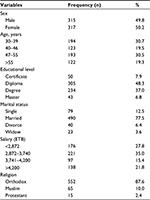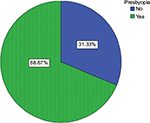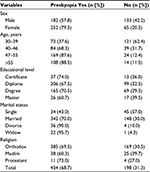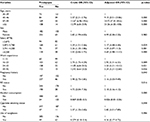Back to Journals » Clinical Optometry » Volume 9
Prevalence and associated factors of presbyopia among school teachers in Gondar City, Northwest Ethiopia, 2016
Authors Andualem HB , Assefa NL , Weldemichael DZ, Tefera TK
Received 3 December 2016
Accepted for publication 10 February 2017
Published 20 April 2017 Volume 2017:9 Pages 85—90
DOI https://doi.org/10.2147/OPTO.S129326
Checked for plagiarism Yes
Review by Single anonymous peer review
Peer reviewer comments 2
Editor who approved publication: Mr Simon Berry
Hiwot Berhanu Andualem, Natnael Lakachew Assefa, Dawit Zenebe Weldemichael, Tsehay Kassa Tefera
Department of Optometry, College of Medicine and Health Sciences, University of Gondar, Gondar, Ethiopia
Introduction: Presbyopia is an age-related decline in accommodation that diminishes the ability of the eye to focus on near objects. This is due to reduced elasticity of the crystalline lens as age increases. It causes near-vision impairment and affects near work, so it has significant effects on quality of life, particularly in the life of teachers, whose work depends mostly on reading and writing at short distances.
Objective: The overall objective of the study was to assess the prevalence and associated factors of presbyopia among school teachers in Gondar city, Northwest Ethiopia, 2016.
Methods: A cross-sectional study design with multistage simple random sampling technique was used to select 668 teachers in Gondar city. The study was conducted in 12 schools from April 15 to May 15, 2016. A pretested structured questionnaire and ophthalmic instruments for an eye examination were used as data collection tools by trained optometrists. Epi Info version 7 was used for data entry, and the data were exported to Statistical Package for Social Science version 20 for further analysis. Multivariate logistic regression was employed using enter method and odds ratio with 95% confidence interval, and p-value of ≤0.05 was considered to identify statistically significant associated factors of the outcome.
Results: Prevalence of presbyopia among school teachers was 68.7%. Out of the total examined subjects, 317 (50.2%) were females. On multivariate analysis, increased age, salary, work experience, cigarette smoking, pregnancy, and refractive error were positively and significantly associated with presbyopia. On the other hand, use of sunglasses and alcohol consumption were inversely and significantly associated with presbyopia.
Conclusion and recommendation: The study had demonstrated a higher prevalence of presbyopia among school teachers. Further investigation is recommended to assess the effect of alcohol consumption on presbyopia.
Keywords: presbyopia, school teachers, Gondar, Ethiopia
Introduction
Presbyopia is an age-related decline in accommodation that diminishes the ability of the eye to focus on near objects. This is due to reduced elasticity of the crystalline lens as the age increases, and the eye cannot focus clearly at near distance.1,2 It is the most common physiological change occurring in the adult eye and is thought to cause universal near-vision impairment with advancing age.3
Blurred vision and the inability to see fine details at the customary near-working distance are the hallmarks of presbyopia. Anyone over the age of 35 years is at risk for developing presbyopia. Everyone experiences some loss in focusing power for near objects as they age, but some will notice this and manifest the symptoms earlier than others.4
Presbyopia cannot be cured, but individuals can compensate or correct it by wearing single vision, bifocal, or progressive eyeglasses, and recently, contact lens can be an option too. Generally, a convex lens is used to make up for the lost automatic focusing power of the eye.5
There are evidence that showed a strong link between presbyopia with sociodemographic variables of the population. In Brazil, a population-based study found that increase in age and female sex were directly associated with presbyopia, and women become presbyopic earlier than men.6 According to the study conducted in the state of Andhra Pradesh, South India, increase in age, female sex, rural residence, myopia, and hyperopia were directly associated with presbyopia, but alcohol consumption is inversely associated with presbyopia.7
People living with presbyopia suffer with their day-to-day activities due to reduced near vision. Even though presbyopia is easily corrected, globally, there are 517 million (49.7%) presbyopes who had no spectacles or inadequate spectacles.8 Uncorrected presbyopia has significant effect on the quality of life, particularly in the life of teachers, whose work depends mostly on reading and writing. So, adequate correction is needed for teachers to maximize their performance, efficacy, and quality of life. The overall objective of the study was to assess the prevalence and associated factors of presbyopia among school teachers in Gondar city, Northwest Ethiopia, 2016.
Methods and materials
School-based cross-sectional study design was conducted from April 15 to May 15, 2016. The study was conducted in Gondar city. Gondar city is located 738 km away from Northwest of Addis Ababa, the capital city of Ethiopia, and 173 km from the capital city of Amhara regional state, Bahir Dar city. In Gondar city, there are 64 elementary and 14 secondary schools, both private and governmental. Within these schools, there are 2002 (816 males and 1,186 females) teachers teaching in elementary and 857 (581 males and 276 females) teachers teaching in secondary schools, totally 2,859 teachers are found in the city (Gondar zonal educational office, unpublished data, 2015). One governmental tertiary eye care and training center with refraction service and two private higher ophthalmic clinics are found in the study area (Five-year project plan, unpublished data, 2017).
All teachers, currently teaching in elementary and secondary schools in Gondar city, Northwest Ethiopia, 2016, were included in this study excluding those with ocular conditions that prevent refraction such as bilateral cataract and corneal opacity; those with binocular vision anomalies that can affect near vision; and those who were absent after three visits from school for various other reasons.
Sample size was determined by considering the prevalence and associated factors using single population proportion formula with the following assumptions: confidence level =95%, margin of error=5%, and prevalence=68.1% from the study in Ghana on teachers, March, 2011.9 When considering the design effect, 668 study participants were included in the study. A multistage simple random sampling technique was used in this study as follows: schools were classified into two groups, elementary and secondary schools. Then, 10 (15%) of 64 elementary schools and 2 (15%) of 14 secondary schools were selected to ensure their representativeness by simple random sampling technique.
Presbyopes
A person aged greater or equal to 35 years who is unable to read N6 at 40 cm with best-corrected distance prescription and improving near vision with addition lenses.9,10
Alcohol consumption
Classified as yes or no by asking the previous or current history of drinking alcohol. Yes, if they drink more than three units of alcohol (a single unit is 300 mL) a day or most day of a week.11
Smoking cigarette status
Classified as yes or no by asking the previous or current history of smoking cigarette. Yes, if a person smokes any tobacco product either daily or occasionally. No, if a person never smokes at all or has smoked less than 100 cigarettes throughout his lifetime.12
Refractive error (RE)
After retinoscopy and subjective refraction, if we found hyperopia of ≥ +0.50 D, myopia of ≥ –0.50 D, and astigmatism of ≥0.50D on either of eyes were considered having an RE.
Teachers were undergoing an interview (face to face) using a pretested structured questionnaire in order to obtain information on sociodemographic and personal data.
The questionnaire was prepared in English and translated from English to Amharic version and vice verse to check consistency and then was pretested; necessary corrections were made before actual data collection. One-day training was given to the data collectors (four optometrists) and a supervisor. The supervisor and principal investigator were closely supervising the entire data collection process. The filled-out questionnaires and examination results were collected after checking for consistency and completeness on a daily basis. Double entry of 5% data for checking errors was conducted.
Epi Info version 7 (CDC, Atlanta, GA, USA) was used for data entry, and SPSS version 20 (IBM Corporation, Armonk, NY, USA) was used for further analysis. Binary and multivariate logistic regressions were employed, and variables with significance level of p≤20% in the bivariate analysis were entered to the multivariate logistic regression model using enter method.
Before the commencement of the study, institutional ethical approval was obtained from the University of Gondar Research Ethical Review Board, and the permission letter was obtained from Gondar Zonal Health Office. Directors of each school were briefed on the importance of the study and permission was acquired; then, the selected teachers were informed about the purpose of the study, importance of their participation, and their right to withdraw at any time before verbal informed consent was obtained prior to data collection. Information from each respondent was kept properly by removing personal identifiers and taking examination in private room to respect privacy and confidentiality of participants.
Results
A total of 632 school teachers were involved in this study with a response rate of 95%. Out of these, 317 (50.2%) were females, and 490 (77.6%) were married. The median age of participants was 46 years within the range of 30–68 years. From all participants, 31% of them were in the age group of 30–39 years. Three hundred and five (48.3%) were diploma teachers (Table 1).
  | Table 1 Sociodemographic characteristics of school teachers in Gondar city, Northwest, Ethiopia, 2016 (n=632) (n=sample size) Abbreviation: ETB, Ethiopian Birr. |
From a total of 632 study participants, there were 434 teachers with presbyopia, and the prevalence of presbyopia was 68.7% at 95% confidence interval (CI) (65.2%–72.5%) (Figure 1).
  | Figure 1 Prevalence of presbyopia among school teachers in Gondar city, Northwest Ethiopia, 2016 (n=632). |
Among 434 presbyopes, 252 (58.1%) were females, and the highest prevalence of 169 (39%) was seen within the age group of 47–55 years. Based on educational level, 206 (47.5%) of presbyopes were diploma teachers, and 342 (78.8%) presbyopes were married (Table 2).
  | Table 2 Distribution of presbyopia among school teachers in Gondar city, Northwest Ethiopia, 2016 (n=632) (n=sample size) |
After employing the binary logistic regression, educational level, religion, and marital status were used as variables, with a significance level p>20%, and they were excluded. Variables with a significance level of p≤20% in the bivariate analysis were entered to the multivariate logistic regression model using enter method, and the results were as follows: age group of 47–55 years (adjusted odds ratio [AOR]: 24.72, 95% CI: 7.31–83.6) was 24.7 times more likely to be presbyopic than age group of 30–39 years; pregnancy history (AOR: 3.16, 95% CI: 1.05–9.49), cigarette smoking (AOR: 2.82, 95% CI: 1.01–7.89), RE (AOR: 2.18, 95% CI: 1.16–4.12), increased salary and work experience were directly and significantly associated with presbyopia, but alcohol consumption (AOR: 0.026, 95% CI: 0.01–0.06) and use of sunglasses (AOR: 0.36, 95% CI: 0.17–0.75) were inversely and significantly associated with presbyopia. In addition, female sex was inversely and insignificantly associated with presbyopia (Table 3).
Discussion
The prevalence of presbyopia in this study was 68.7%, at 95% CI: (65.2%–72.5%). This seems to be high when compared with the prevalence from studies in Brazil (54.7%),6 South India (55.3%),7 Tanzania (62%),13 and Nigeria (30.4%).14 This might be due to the fact that this study considered only school teachers, unlike other studies that considered the general population.
In a study conducted in Ghana, among senior school teachers, the prevalence was 68.1%,9 which is similar to this study. This can be due to the similarity in the source population used in both studies. In a study in Kenya, the prevalence was 85.4%.15 The higher value might be due to the source population again, which included age group of at least 50 years.
Increment of age is directly and significantly associated with presbyopia, similar to other studies in Brazil,6 South India,7 Tanzania,16 and Nigeria.14 This can be due to the fact that the firmness of the lens nucleus increases with age, and this hardening of nucleus occurring between the ages of 20 and 60 years coincides with the decrease in accommodation range and the onset of presbyopia.17
Teachers having a history of pregnancy (AOR: 3.16, 95% CI: 1.05–9.49) are 3.16 times more likely to be presbyopic than those who do not have a history of pregnancy. It is possible that hormonal influences play a role in the onset of presbyopia, and a study done in central India18 found a positive significant association between childbearing and cataract (opacity of the lens). Cigarette smoking (AOR: 2.82, 95% CI: 1.01–7.89) is directly and significantly associated with presbyopia. This might be due to accumulation of metal ions in the human lens, causing nuclear opacity and hardening of the lens, which will affect accommodation.19,20 Subjects having an RE (AOR: 2.18, 95% CI: 1.16–4.12) are 2.18 times more likely to be presbyopic than those who do not have an RE, in line with the study done in South India.7 As salary increases, prevalence of presbyopia increases, and this might be because those who have longer years of service have better salary and more are likely of being presbyopic. Similarly, work experience is directly and significantly associated with presbyopia, and this can be due to increment of age with work experience.
On the other hand, alcohol consumption (AOR: 0.026, 95% CI: 0.01–0.06) is inversely and significantly associated with presbyopia, in line with a study done in South India (AOR: 0.8, 95% CI: 0.6–0.9).7 In addition to this, a meta-analysis study reported that moderate alcohol consumption has a protective effect on cataract formation,21 and this can be true for presbyopia too. Similarly, using sunglasses (AOR: 0.36, 95% CI: 0.17–0.75) is inversely and significantly associated with presbyopia. This might be due to protective effect of sunglass from ultra-violet light radiation exposure, which can increase sclerosis of the lens and can affect elasticity of the lens.22
Educational level and female sex have statistically insignificant effect on presbyopia, but studies conducted in Nigeria14 and Tanzania16 found a direct significant association with presbyopia. This might be due to the similar levels of education among teachers and restricted age distribution of female participants in this study.
Conclusion
The prevalence of presbyopia among school teachers is high. Proper and adequate correction is needed for all presbyopic teachers to do their job effectively.
Generally, increased age, cigarette smoking, pregnancy history, RE, increased salary, and teaching experience were positively and strongly associated with presbyopia. On the other hand, alcohol consumption and using sunglasses were found to have a protective effect on presbyopia.
Author contributions
All authors contributed toward data collection, data analysis, drafting and critically revising the paper and agree to be accountable for all aspects of the work.
Acknowledgments
We would like to thank North Gondar Zonal Educational Office for giving the list of teachers for the purpose of this study and University of Gondar, College of Medicine and Health Sciences, Department of Optometry for arranging and sponsoring this research. Finally, we would also like to thank all data collectors, participants, and entire colleagues who helped us in this research.
Disclosure
The authors report no conflicts of interest in this work.
References
Weale RA. Epidemiology of refractive errors and presbyopia. Surv Ophthalmol. 2003;48(5):515–554. | ||
Borish I. Clinical Refraction. 3rd ed. Chicago, IL: Professional Press; 1970. | ||
Koretz JF, Kaufman PL, Neider MW, Goeckner PA. Accommodation and presbyopia in the human eye – aging of the anterior segment. Vision Res. 1989;29(12):1685–1692. | ||
Grosvener T. Primary Care Optometry. 4th ed. 2002; 115–117. | ||
Longe JL. The Gale Encyclopedia of Medicine. 2nd ed., Vol. 4. New York, NY: Thomson Gale Group; 2002: 2713–2714. | ||
Duarte WR, Barros AJ, Dias-da-Costa JS, Cattan JM. Prevalência de deficiência visual de perto e fatores associados: um estudo de base populacional [Prevalence of near vision deficiency and related factors: a population based study in Brazil]. Cad Saude Publica. 2003;19(2):551–559. Portuguese. | ||
Nirmalan PK, Krishnaiah S, Shamanna BR, Rao GN, Thomas R. A population-based assessment of presbyopia in the state of Andhra Pradesh, south India: the Andhra Pradesh Eye Disease Study. Invest Ophthalmol Vis Sci. 2006;47(6):2324–2328. | ||
Holden BA, Fricke TR, Ho SM. Global vision impairment due to uncorrected presbyopia. Arch Ophthalmol. 2008;126(12):1731–1739. | ||
Kumah DB, Lartey SY, Amoah-Duah K. Presbyopia among public senior high school teachers in the Kumasi metropolis. Ghana Med J. 2011;45(1):27–30. | ||
Uche JN. Prevalence of presbyopia in a rural African community. Rural Remot Health. 2014;14(3):2731. | ||
Adult drinking habits in Great Britain: 2014. Available from https://www.ons.gov.uk/peoplepopulationandcommunity/healthandsocialcare/drugusealcoholandsmoking/bulletins/opinionsandlifestylesurveyadultdrinkinghabitsingreatbritain/2014. Accessed March 16, 2017. | ||
World Health Organization. Guidelines for Controlling and Monitoring the Tobacco Epidemic. Geneva: WHO; 1998. | ||
Patel I. Impact of presbyopia on quality of life in a rural African setting. Ophthalmology. 2006;113(5):728–734. | ||
Umar MM, Muhammad N, Alhassan MB. Prevalence of presbyopia and spectacle correction coverage in a rural population of North West Nigeria. Clin Ophthalmol. 2015;9:1195–1201. | ||
Sherwin JC, Keeffe JE, Kuper H, Islam FM, Muller A, Mathenge W. Functional presbyopia in a rural Kenyan population: the unmet presbyopic need. Clin Exp Ophthalmol. 2008;36(3):245–251. | ||
Burke AG. Population-based study of presbyopia in rural Tanzania. Ophthalmology. 2006;113(5):723–727. | ||
Pau H, Kranz J. The increasing sclerosis of the human lens with age and its relevance to accommodation and presbyopia. Graefes Arch Clin Exp Ophthalmol. 1991;229(3):294–296. | ||
Minassian DC, Mehra V, Reidy A. Childbearing and risk of cataract in young women: an Epidemiological study in central India. Br J Opthalmol. 2002;86(5):548–550. | ||
Langford-Smith A, Tilakaratna V, Lythgoe PR, Clark SJ, Bishop PN, Day AJ. Age and smoking related changes in metal ion levels in human lens: implications for cataract formation. PLoS One. 2016;11(1):e0147576. | ||
Richter GM, Choudhury F, Torres M, Azen SP, Varma R; Los Angeles Latino Eye Study Group. Risk factors for incident cortical, nuclear, posterior subcapsular, and mixed lens opacities: the Los Angeles Latino eye study. Ophthalmology. 2012;119(10):2040–2047. | ||
Gong Y, Feng K, Yan N, Xu Y, Pan CW. Different amounts of alcohol consumption and cataract: a meta analysis. Optom Vis Sci. 2015;92(4):471–479. | ||
Yu JM, Yang DQ, Wang H. Prevalence and risk factors of lens opacities in rural populations living at two different altitudes in China. Int J Ophthalmol. 2016;9(4):610–616. |
 © 2017 The Author(s). This work is published and licensed by Dove Medical Press Limited. The full terms of this license are available at https://www.dovepress.com/terms.php and incorporate the Creative Commons Attribution - Non Commercial (unported, v3.0) License.
By accessing the work you hereby accept the Terms. Non-commercial uses of the work are permitted without any further permission from Dove Medical Press Limited, provided the work is properly attributed. For permission for commercial use of this work, please see paragraphs 4.2 and 5 of our Terms.
© 2017 The Author(s). This work is published and licensed by Dove Medical Press Limited. The full terms of this license are available at https://www.dovepress.com/terms.php and incorporate the Creative Commons Attribution - Non Commercial (unported, v3.0) License.
By accessing the work you hereby accept the Terms. Non-commercial uses of the work are permitted without any further permission from Dove Medical Press Limited, provided the work is properly attributed. For permission for commercial use of this work, please see paragraphs 4.2 and 5 of our Terms.

